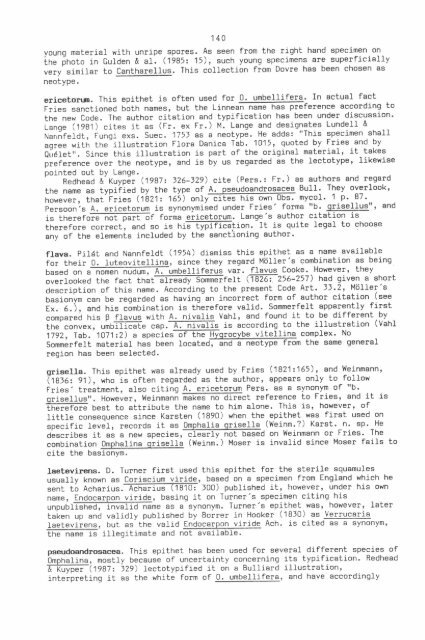-ry wL - Universitetet i Oslo
-ry wL - Universitetet i Oslo
-ry wL - Universitetet i Oslo
You also want an ePaper? Increase the reach of your titles
YUMPU automatically turns print PDFs into web optimized ePapers that Google loves.
140<br />
young material with unripe spores. As seen from the right hand specimen on<br />
lnu 6noto in Gulden & al. (1985: 15), such young specimens are superficially<br />
ve<strong>ry</strong> similar to cantharellus. This collection from Dovre has been chosen as<br />
neotype.<br />
ericetorrn. This epithet is often ueed for 0. umbellifera. In actual fact<br />
Fries sanctioned both names, but the Linneai-i?ifiFlGference according to<br />
the new Code. The author citation and typification has been under discussion.<br />
i""g"-(fSAi) cites it as (Fr. ex Fr.) M. Lange and designates Lundell &<br />
ll"nif"iat, iungi exs. Suec. 1751 as a neotype. He adds: "This specimen shall<br />
agree with the illustration Flora Danica Tab' 1015, quoted by Friee.and by<br />
Qt1€letu. Since this illustration is part of the original material, it takes<br />
preference over the neotype, and is 6y us regarded as the lectotype' likewise<br />
oointed out bY Lanqe.<br />
--- n"Jf,""A &'Kuyp6r (98': . tZ6-tZ9) cite (Pers.: Fr.) as authors and regard<br />
the name as typi'fied by the type of A. pseudoandrosggea Bull. They overlookt<br />
hor"u"", that'Fries (AZlz 1e5) only-Ef6Tis own-0bs' mycol' 1 p'-87'<br />
Persoonis A, ericetorum is synonymiled under Fries'forma "b' gPllg"'<br />
is therefoft-iffilEiETf forma eiicetorum. Lange's author citation is<br />
iherefore correct, and so is n:.Spi-fication. It is quite legal to ehoose<br />
any of the elements included by the sanctioning author'<br />
flava. Pil6t snd Nannfeldt (1954) dismiss this ePithet as a name available<br />
for their 0. luteovitellina, since they regard Mijller's combination as being<br />
basedonanomennuoum|-A.uqbe1111prgqvai.-1ravu9Cooke'However,they<br />
overlooked the fact tnlt-ef f en (ffilZS6-257) had given a short<br />
description of this name. Accoriing to the present Code Art. 33.2t Mtiller's<br />
basionym can be regarded as having an incorrect form of author citation (see<br />
i". g.i, and his c6mbination is therefore valid. Somrnerfelt apparently first<br />
"orp"""d his B flavus with A. niv61i8 VahI, and found it to be different_by<br />
the convex, umUTGiTe is according to the iflustration (VahI<br />
1792, Iab.'1O7122) a species@ ""p.@<br />
complex' No<br />
Sonrmerfelt material has been locatedl-End a-neotype from the same general<br />
region hae been selected.<br />
sriaella. This epithet was already used by Fries (1821:.,|65), and I'leinmann,<br />
(ft1e, gl), who is often regarded as the author, aPPears only to^follow<br />
Fries'treatment, also citing A. ericetorum Pets. as a synonym of'rb'<br />
orisellust,. However, Weinmann fr'a6-no-Elrect reference to Fries, end it is<br />
Tffi;fore best to attribute the name to him alone. This is, however, of<br />
Iittle consequence since Karsten (1890) when the.epithet.was firEt uaed on<br />
specific leveI, records it as 0mphalia qrisella (Weinm.?) Karst' n' sp' He<br />
describes it as a new species,GTif-iiT61-se-d on Weinmann or Fries. The<br />
combination 0mphaline qrieella (Weinm.) Moser is invalid since Moser fails to<br />
cite the basionym,<br />
laetevircns. D. Turner first used this epithet for the sterife squamules<br />
usually known as corisciurn viride, based on a specimen from England which he<br />
sent to Acharius.Tcfr:rGTT610-l 100) published it, however, under his own<br />
name, Endocarpon viride, basing it on Turner's specimen citing his<br />
unpuu1easasynonym.TUrner,sepitheL.was,however,1ater<br />
talen up and validly published by Borrer in Hooker (t810) as ]errucgria<br />
Iaetevirens, but as the valid Er:rdocaTpolr_viride Ach. is cited as a synonym'<br />
Ehe narne is illegitimate and not available.<br />
pseudoandrosacee. This epithet has been used for several different species of<br />
bmphalina. mostly because of uncertainty concerninq its typification' Redhead<br />
E-'iiiiFer (ts87: )29) leetotypified it on e Bulliard illustration'<br />
inteipreting it as the white form of L urleuifere, and have accordingly<br />
and

















